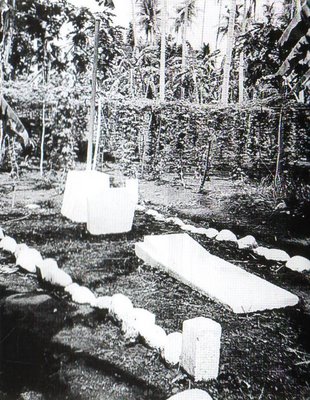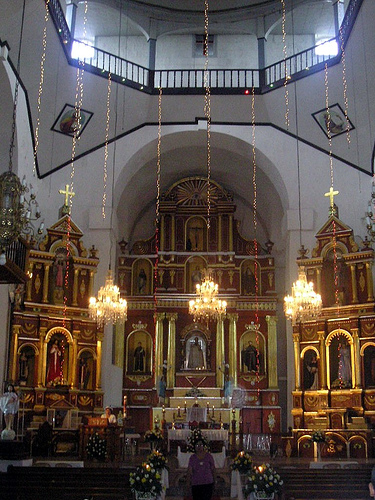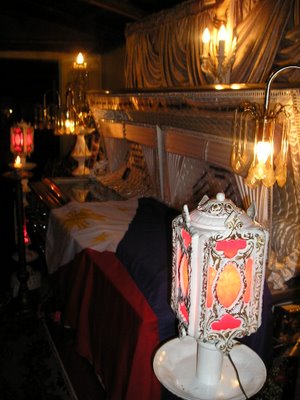In 1987, a big issue raged at the High School Department of the Nueva Vizcaya State Polytechnic College (NVSPC). One of its senior students flunked 3 major subjects and will not graduate. The problem is the same student was one of the school’s top three performers in the National College Entrance Examination. The issue is whether to reward him a medal for this achievement when he will not be joining the graduating class. In the end, there was no medal --- a scenario that will be replicated many years later in another school in nearby Nueva Ecija.

If one is traveling towards Lucban in Quezon province, the next town afterMagdalena following the right fork of the road (the left fork leads to Majayjay) will be Liliw. It was once called as Lilio and was established as a Franciscan visita of Nagcarlang in 1571 until 1605. Its first church was made of wood and built in 1620. A stone church --- dedicated to San Juan Bautista ---was started to be constructed in 1643 that was finished in 1646. This was seriously damaged during the 1880 earthquake and was reconstructed in 1885. The church suffered minor damages when Col. Buenaventura Dimaguila liberated Lilio during the Philippine revolution against Spain

Another right turn from Liliw is the town ofNagcarlan church of San Bartolome


National Heritage Site: A Catwalk to Heaven

On October 5 this year, retired 2Lt. Guillermo “Kidlat” Lazaro --- survivor of 27 years of war --- was side swept by a bus while on his way to buy cigarettes. He was 61 years old. He was buried with full military honors 10 days later in Almaguer.
PHOTOS (from top to bottom):
And so it was that Abet fled Almaguer to escape the wrath of Kid Buntal. He first took refuge among his cousin soldiers in Fort Magsaysay Manila Magdalena , Llaguna.
Uncle Kidlat’s outfit in Baanan is the 4th GHQ Battalion of the Armed Forces of the Philippines
Later, Uncle Kidlat brought Abet to Fort Bonifacio
The sleepy town of Magdalena Magdalena ’s first parish priest in 1921, probably started the construction. The bell tower was later added in 1861 while the convent was built from 1871 to 1872.





If one is traveling towards Lucban in Quezon province, the next town after

Another right turn from Liliw is the town of


National Heritage Site: A Catwalk to Heaven
Turning back to Liliw towards Luisiana or Lucban is Majayjay that was first established as an encomienda in 1571. The first church in the area was built of light materials in 1573 by the Augustinians in a place called Sitio May-it. This and the next three churches were destroyed by fire: the Augustinian church in 1576, the church built in 1578 by Fr. Juan de Plasencia (OFM) after the Franciscans took over, a stone church in 1606, and its replacement in 1660. Fr. Jose de Puertollano (OFM) had the present church of San Gregorio Magno Magdalena





On October 5 this year, retired 2Lt. Guillermo “Kidlat” Lazaro --- survivor of 27 years of war --- was side swept by a bus while on his way to buy cigarettes. He was 61 years old. He was buried with full military honors 10 days later in Almaguer.
PHOTOS (from top to bottom):
1) A monument marking the supposed bloodstains of the wounded Emilio Jacinto. The marker reads: "Dito napahimpil na may sugat ang katawan ng Hen. Emilio Jacinto ng Pebrero ng 1898 dahil sa labanan sa Maimpis, sakop ng bayang ito, laban sa mga kawal ng Pamahalaang Kastila. Ang mga dugong nakikita sa baldosa ay tunay na kanya."
2) The site where Emilio Jacinto was wounded in Maimpis, Magdalena. The marker reads: "Sa pook na ito ng Maimpis binaril ng mga kawal ng Pamahalaang Kastila si Emilio Jacinto noong Pebrero 1898 kaugnay ng himagsikan ng Pilipinas noong 1896-1898."
2) The site where Emilio Jacinto was wounded in Maimpis, Magdalena. The marker reads: "Sa pook na ito ng Maimpis binaril ng mga kawal ng Pamahalaang Kastila si Emilio Jacinto noong Pebrero 1898 kaugnay ng himagsikan ng Pilipinas noong 1896-1898."
3) The church of Santa Magdalena in Magdalena, Laguna.
4) The church of San Juan Bautista in Liliw, Laguna.
5) The church of San Bartolome in Nagcarlan, Laguna.
6) Entrance to the Nagcarlan underground cemetery.
7) Majayjay's church of San Gregorio Magno in Laguna.
8) The langit-langitan can be seen above the main altar of the Majayjay church.
9) Emilio Jacinto's Recuerdos de Patay in Majayjay. The practice of taking photos of the dead is common in some parts of Nueva Ecija.
10) Emilio Jacinto's grave in Majayjay. His remains were later exhumed and reinterred at the Mausoleo de Veteranos de la Revolucion then at the Himlayang Pilipino Memorial Park.
12) Uncle Kidlat's wake.
CREDITS:
Emilio Jacinto's Recuerdos de Patay photo was taken from Ambet Ocampo's "Looking Back" while that of his grave is from"Kasaysay: The Story of the Filipino People".


No comments:
Post a Comment